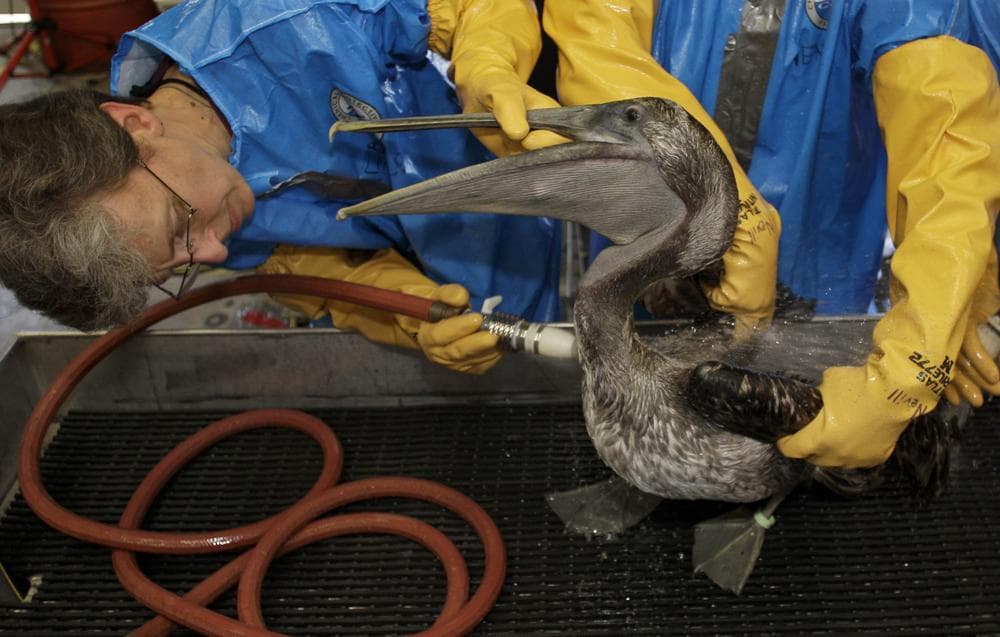Advertisement
Huge Oil Plumes Found In Gulf As BP Fix Struggles

Oil from a blown-out well is forming huge underwater plumes as much as 10 miles long below a visible slick in the Gulf of Mexico, scientists said as BP wrestled for a third day Sunday with its latest contraption for slowing the nearly month-old gusher.
BP, the largest oil and gas producer in the U.S., has been unable to thread a tube into the leak to siphon the crude to a tanker, it's third approach to stopping or reducing the spill on the ocean floor nearly a mile below the surface. Engineers remotely steering robot submersibles were trying again Sunday to fit the tube into a breach in a seafloor pipe, BP said.
Oil has been spewing since the rig Deepwater Horizon exploded April 20, killing 11 people and sinking two days later. The government shortly afterward estimated the spill at 210,000 gallons - or 5,000 barrels - a day, a figure that has since been questioned by some scientists who fear it could be far more. BP executives have stood by the estimate while acknowledging there's no way to know for sure.
BP also owns a rig that operated with incomplete and inaccurate engineering documents, which one official warned could "lead to catastrophic operator error," records and interviews show.
Two months before the Deepwater Horizon accident, 19 members of Congress called on the agency that oversees offshore oil drilling to investigate a whistle-blower's complaints about the BP-owned Atlantis, which is stationed in 7,070 feet of water more than 150 miles south of New Orleans.
The Associated Press has learned that an independent firm hired by BP substantiated the complaints in 2009 and found that the company was violating its own policies by not having completed engineering documents on board the Atlantis when it began operating in 2007.
Word of huge submerged oil plumes, meanwhile, raised the specter of more damage to the ecologically rich Gulf. It also adds to questions about when large amounts of crude might hit shore.
"It's just a matter of time ... and the first significant amount of oil is going to show up around the U.S," said Hans Graber, director of the University of Miami's satellite sensing facility, who has been tracking the oil slick.
Researchers from the National Institute for Undersea Science and Technology said Saturday they had detected the underwater oil plumes at depths between just beneath the surface to more than 4,000 feet.
Three or four large plumes have been found, at least one that is 10 miles long and a mile wide, said Samantha Joye, a marine science professor at the University of Georgia.
Researchers Vernon Asper and Arne Dierks said in Web posts that the plumes were "perhaps due to the deep injection of dispersants which BP has stated that they are conducting." BP has won government approval to use chemicals on the oil near where it is gushing to break it up before it rises to the surface.
The researchers were also testing the effects of large amounts of subsea oil on oxygen levels in the water. The oil can deplete oxygen in the water, harming plankton and other tiny creatures that serve as food for a wide variety of sea critters.
Oxygen levels in some areas have dropped 30 percent, and should continue to drop, Joye said.
"It could take years, possibly decades, for the system to recover from an infusion of this quantity of oil and gas," Joye said. "We've never seen anything like this before. It's impossible to fathom the impact."
Joye's lab was waiting for the research boat to return so a team of scientists can test about 75 water samples and 100 sediment samples gathered during the voyage. Researchers plan to go back out in about a month and sample the same areas to see if oil and oxygen levels have worsened.
BP has been unable to stop the gusher with huge blowout preventers on the well or by putting a 100-tone box above the flow to trap and siphon it to a tanker on the surface. The latest effort, inserting a mile-long pipe into the largest of two leaks, hit a snag Saturday.
BP chief operating officer Doug Suttles said one piece of equipment, called the framework, had to be brought to the surface and adjusted to fit with the tube.
The framework holds a pipe and stopper. If it works, the tube could capture more than three-quarters of the leak. BP also must contend with a smaller leak that's farther away.
One expert said BP's latest idea seems to have the best chance for success so far. Inserting a pipe into the oil gusher would be easy at the surface, said Ed Overton, a LSU professor of environmental studies. But using robots in 5,000 feet of water with oil rushing out of the pipe makes things much more difficult.
"It's something like threading the eye of a needle. But that can be tough to do up here. And you can imagine how hard it would be to do it down there with a robot," Overton said.
BP is also drilling a relief well that is considered the permanent solution to stopping the leak. It's about halfway done and still months away from being completed. The company also is still considering using a smaller containment dome known as a "top hat," as well as a "junk shot," in which golf balls and rubber would be inserted to try to clog the leak.
This program aired on May 16, 2010. The audio for this program is not available.